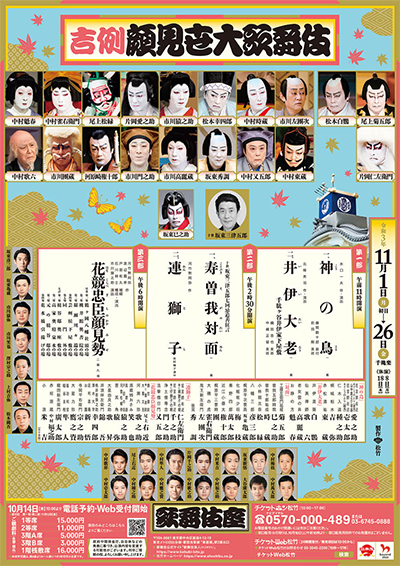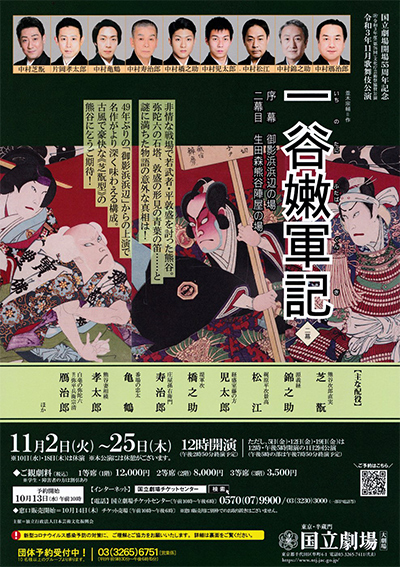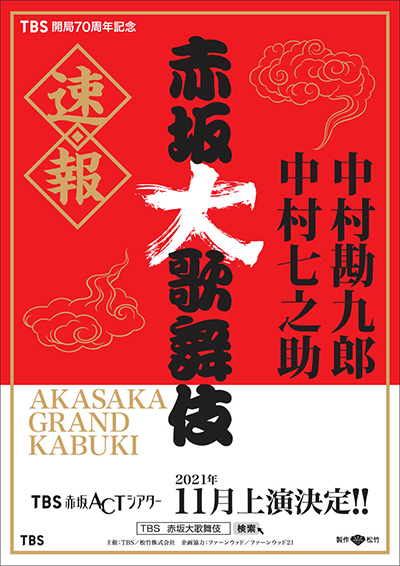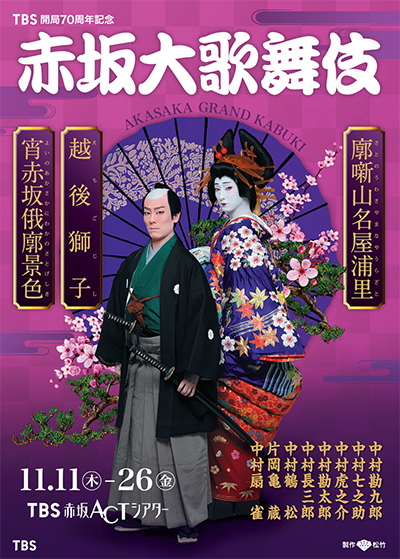| NOVEMBER 2021 |
| Cancellation of one Kabuki program in November 2021 due to coronavirus (COVID-19)!!! |
|
5 shows in T˘ky˘ (Kabukiza, National Theatre, TBS Akasaka Act Theater), 1 in Toyooka (Eirakukan) and 1 tour (Hana no Mai Tour)!
|
| Kabukiza (T˘ky˘) |  |
| Dates | 1 ~ 26 November 2021 Kichirei Kaomise ďkabuki Annual Festive Face-Showing Grand Kabuki |
| 1st program |
K˘ no Tori |
| 2nd program | |
| 3rd program |
Hana Kurabe Gishi no Kaomise |
| Casting |
Living National Treasure Onoe Kikugor˘, Living National Treasure Kataoka Nizaemon, Living National Treasure Nakamura T˘z˘, Matsumoto Haku˘, Nakamura Tokiz˘, Nakamura Jakuemon, Matsumoto K˘shir˘, Nakamura Kaishun, Kataoka Ainosuke, Ichikawa Ennosuke, Onoe Sh˘roku, Ichikawa Sadanji, Ichikawa Danz˘, Nakamura Karoku, Nakamura Matagor˘, Band˘ Hikosabur˘, Onoe Ukon, Ichikawa Monnosuke, Band˘ Minosuke, Nakamura Kazutar˘, Nakamura Baishi, Nakamura Hayato, Band˘ Kamez˘, Kawarasaki Gonjűr˘, Ichikawa Komaz˘, Kamimura Kichiya, Band˘ Shingo, Nakamura Yonekichi, ďtani Hirotar˘, Nakamura Kash˘, Kataoka Sennosuke, Nakamura Tanenosuke, Nakamura Mantar˘ |
| Comments |
The traditional November kaomise programs at the Kabukiza.
|
 |
| National Theatre (T˘ky˘) |
| Dates | 2 ~ 25 November 2021 |
| Program |
|
| Casting |
Nakamura Shikan, Nakamura Ganjir˘, Nakamura Kinnosuke, Kataoka Takatar˘, Nakamura Kotar˘, Nakamura Kikaku, Nakamura Matsue, Nakamura Hashinosuke, Nakamura Jűjir˘, Nakamura Kichinoj˘, Ichimura Takematsu, Ichikawa Otora, Nakamura Tamatar˘ |
| Comments |
The usual November Kabuki at the National Theatre.
|
 |
| TBS Akasaka Act Theater (T˘ky˘) |
| Dates | 11 ~ 26 November 2021 Akasaka ďkabuki Akasaka Grand Kabuki |
| Program |
Sato no Uwasa Yamanaya Urazato Yoi no Akasaka Niwaka no Satogeshiki |
| Casting |
Nakamura Kankur˘, Nakamura Shichinosuke, Nakamura Senjaku, Kataoka Kamez˘, Nakamura Tsurumatsu, Nakamura Toranosuke, Nakamura Kantar˘, Nakamura Ch˘zabur˘ |
| Comments |
5th edition of the Akasaka Grand Kabuki, which was started in September 2008 by Nakamura Kanzabur˘ XVIII, the head of the Nakamuraya guild. |
 |
 |
| Eirakukan (Toyooka) |  |
| Dates | Eirakukan ďkabuki Eirakukan Grand Kabuki |
| Program |
??? |
| Casting |
??? |
| Comments |
Cancellation of the 13th Kabuki program at the Eirakukan, a renovated traditional theater built in the city of Toyooka (prefecture of Hy˘go). |
| Hana no Mai Tour | |
| Dates | 14 October ~ 23 November 2021 Dent˘ Gein˘ Hana no Mai The Dance of Flowers (Tradional Entertainment) |
| Program |
Kusu no Shu Nank˘ |
| Casting |
Ichikawa Udanji, Ichikawa Emisabur˘, ďtani Hiromatsu, Ichikawa K˘tar˘, Ichikawa Ukon |
| Comments |
A short 17-date tour for Ichikawa Udanji, Ichikawa Emisabur˘ and ďtani Hiromatsu.
|
|
|
| Contact | Main | Top | Updates | Actors | Plays | Playwrights | Programs | Links | FAQ | Glossary | Chronology | Illustrations | Prints | Characters | Derivatives | Theaters | Coming soon | News |